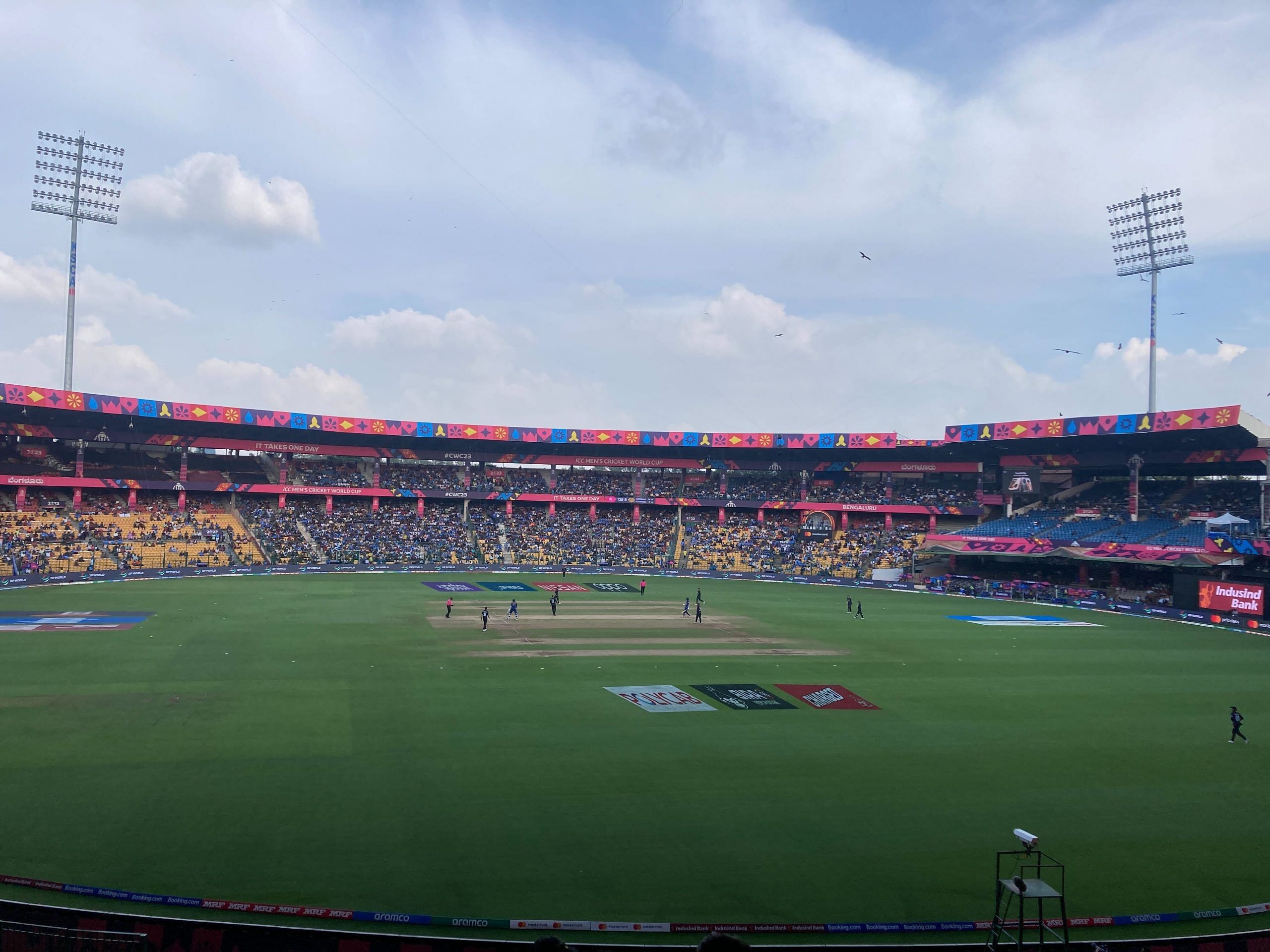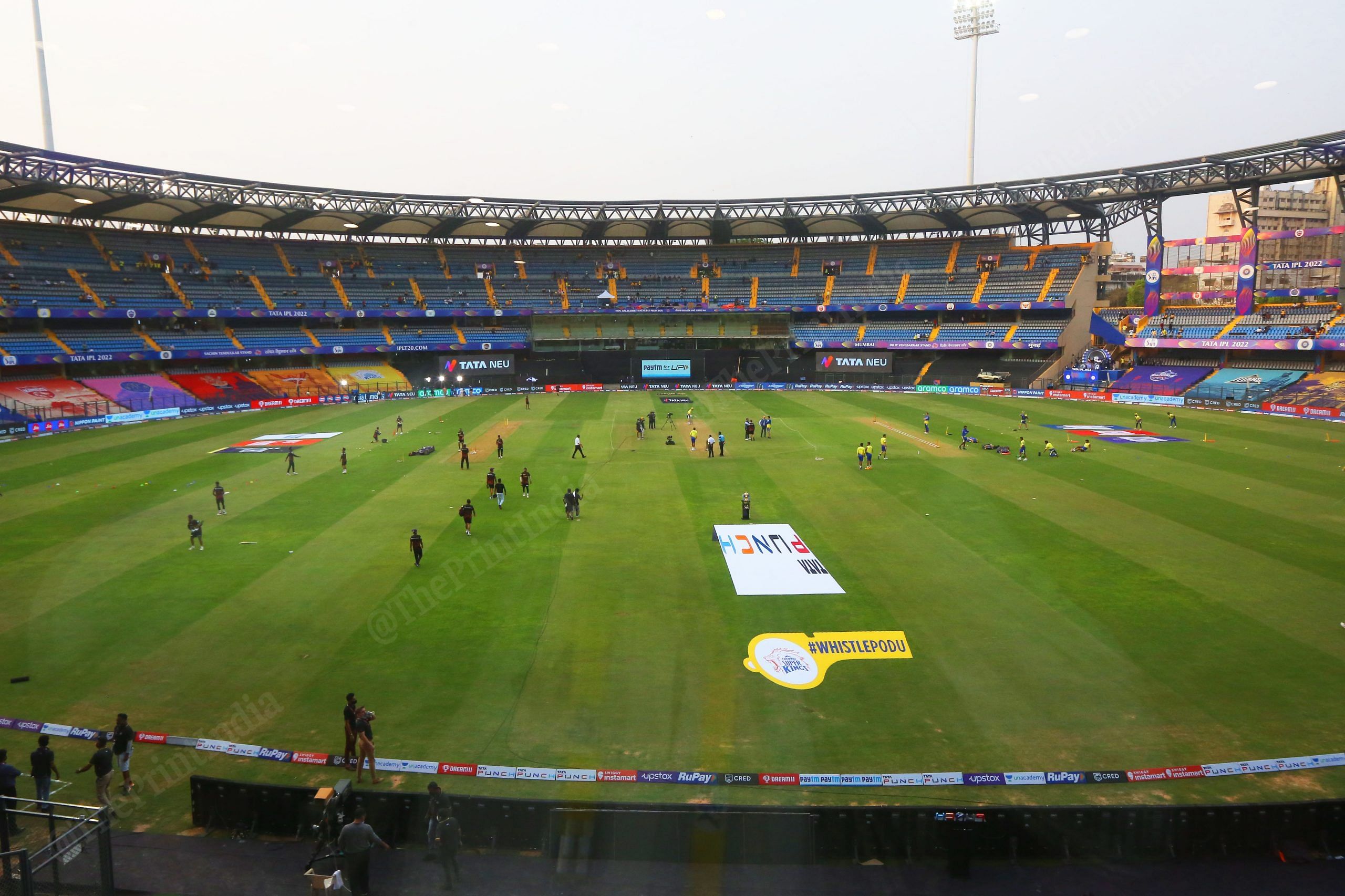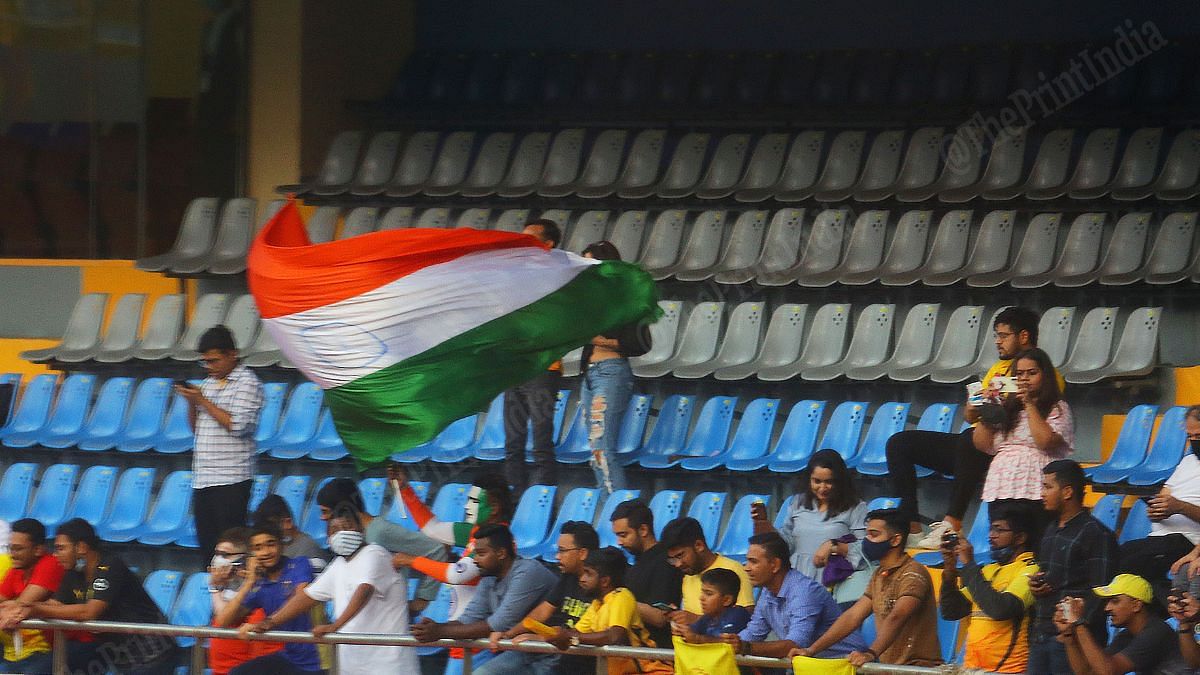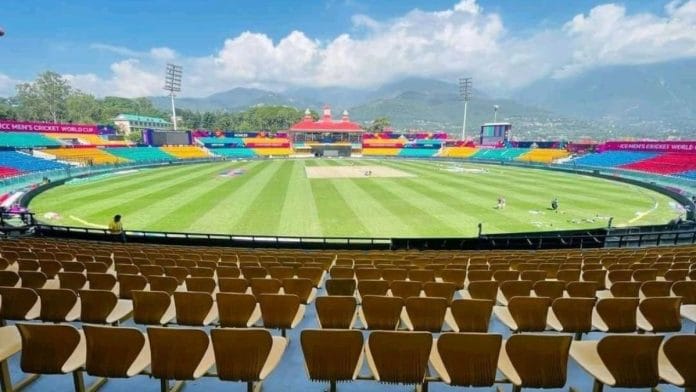New Delhi: When Virat Kohli is not nearing a 100, or Glenn Maxwell is not on a carnage, or when players are catching a breath, be it drinks or innings break, your broadcaster often gives you a drone shot of the stadium where all the action is on. And if you are someone who doesn’t care about the stats on display on your screen, there is a high chance you will notice the lush green grass and the stadium roof that may come across as a venue anywhere but in India. That drone shot captures in more ways than one the extent of improvement India’s cricket stadiums have made vis a vis their infrastructure.
From use of modern equipment for pitch curation and maintenance to improved drainage systems that cut delays due to rains, from sauna baths in dressing rooms to solar panels powering flood lights and other equipment and better access and facilities for fans, including more entry gates and toilets, India’s stadiums are a match every bit the power the nation enjoys in global cricket today.
The picture of Indian cricket stadiums is changing. While the Narendra Modi Stadium in Ahmedabad has hogged all the limelight, particularly due to its name and a massive seating capacity of 1.3 lakh, Bengaluru’s M Chinnaswamy stadium, Kolkata’s Eden Gardens, Delhi’s Arun Jaitley Stadium and Mumbai’s Wankhede Stadium among others have also seen renovation and redevelopment in a big way.
“It was my second time in Arun Jaitley Stadium. When I went inside, I forgot I was in India. It seemed like a foreign venue as we see on TV screens. Outfield was greener, big screens; the infrastructure was so good,” says Bijender Chaudhari, 26, who had gone to watch the Australia-Netherlands match at Kotla.
“When I went to see a Test match in 2008, the seats were of poorer quality and the ground not well managed. Now the seats have become better. Pitches are better and the outfield looks good too,” adds Chaudhari.
The state cricket associations that have led the redevelopment of stadiums have also done their bit towards improving viewing angle for the spectators. “They are bringing a new model in which they are trying to build the system from where everyone can see the field,” says senior sports analyst Sharda Ugra.
Earlier, there were pillars standing in the stands that had fans fixed to them, and an iron net dividing the spectators from the playing area, which used to block the view, says Ugra. Now we also have cushioned seats with clear numbering, making it easier for fans to locate, she adds.
“We have better press boxes, big commentators boxes, wifi facilities etc. In earlier times, spectators used to get beaten by the police. That has stopped now,” says sports commentator and journalist Vijay Lokapally.

Also read: India funding world cricket. And it’s riding on paan masala, tractor, rebar, deo market
Better seats, new drainage systems
Earlier this year, as per media reports, the ten venues currently hosting the World Cup received Rs 50 crore each for sprucing up stadium infrastructure that includes new floodlights and corporate boxes in Mumbai, a new outfield in Dharamshala, a makeshift roof in Pune among others.
However, when ThePrint reached out to the Himachal Pradesh Cricket Association, it denied receiving any such amount from the cricket board.
“Their is no such amount allocated to HPCA for the World Cup; this is just from unconfirmed media reports that we have come to know of this figure. However, we have revamped the whole stadium and fan experience, installed high intensity LED lights, did the path lighting of the passages, facade lighting of the stadium, improved the quality of the seating, (built) 26 world-class washrooms etc,” says Mohit Sood media manager and spokesperson of HPCA.
But some of this new construction at older stadiums has come at the cost of reduction in the seating capacity. If you look at the grainy footage of the 1996 World Cup semifinal between India and Sri Lanka on YouTube, every time Sachin Tendulkar hits Chaminda Vaas for a four and the camera follows the ball to the boundary, you get a glance of the crowd density the Eden Gardens could hold over two decades ago. Today, the focus has shifted toward providing a better experience.
At Eden Gardens, they have upgraded the lighting, redecorated the main foyer, dressing rooms, and corporate boxes, and built a new media center and a hanging press box.
“Many old stadiums were renovated but the seats were deducted at Eden Gardens, Chinnaswamy, Wankhede etc. But seat quality got better and facilities got way better in comparison to the older times,” says Lokkapally.
With the cricketing calendar in India busy as ever and matches being hosted almost throughout the year, cricket administrators had no option but to tackle the rain gods better. That meant bettering the drainage systems. The SubAir system at Bengaluru’s M. Chinnaswamy can dry the playing area in 15 minutes to make it play ready. The vacuum-powered drainage system removes 10,000 liters of water per minute, which is 36 times faster than conventional modes.

“It is an American system that cost Rs 4.5 crore,” says author and cricket expert Vedam Jaishankar.
Himachal Pradesh Cricket Association stadium in Dharamshala too has state-of-the-art drainage system.
“Improved seats and colors, SIS air evacuation drainage system, which can drain the ground in minutes and can be ready to play in flat 20 minutes after a downpour. That was on display during the South Africa vs Netherlands game,” says Sood.
The Chinnaswamy stadium has come up with digital entry gates where spectators can scan the tickets from their mobile phones to enter the premises. The administrators also plan to bring face scanner technology.
“Soon there will be a face recognition system in the stadium. Just like the airports. At the airports we see the smooth entry through the Digi Yatra app, they are trying to bring that technology to the stadium,” says Jaishankar.
We improved seats and added colors, brought SIS air evacuation drainage system, which can drain the ground in minutes after a downpour. That was on display during the South Africa vs Netherlands game
–Mohit Sood, media manager and spokesperson of HPCA
Also read: Cricket-Australia feeling 2021 vibes ahead of South Africa semi-final: Maxwell
Pitching it right
The application of technology has been a key factor in meeting the growing appetite for games on Indian grounds. From a couple of pitches on a given ground to nearly 20 surfaces at some venues today, the redevelopment is also changing the nature of the game in India, raising its standards. Indian pitches are no more batting heaven only.
“Earlier, there used to be 2-3 pitches but now there are 20 pitches at some stadiums. Repeated usage led to faster wear down of the surfaces, making them unfit for use. But with more wickets, rotation has become possible,” says Daljit Singh, retired head curator of BCCI.
Most important thing about a cricket pitch is testing. Earlier we did not use to test the pitches, I started it,” says Singh.
Earlier, there used to be 2-3 pitches but now there are 20 pitches at some stadiums. Repeated usage led to faster wear down of the surfaces, making them unfit for use. But with more wickets, rotation has become possible
–Daljit Singh, retired head curator of BCCI
Pitch conditions provide very important inputs that determine the flight and spin of the ball before it reaches the batsman. So before the match, ICC tests the pitch with their meter. “The ICC team comes a day before the match and tests the pitch. As for us, we can just see the bounce and test it as it is our ground and we are working on it,” says Daljit.
“There was no science before, ground staff used to care about the pitch and the outfield. There was no manual (to follow). Farming fertiliser was used to grow the grass. But then we brought the science to cricket, we read and learnt,” adds Singh.
Methods for pitch curation and outfield development have also undergone changes that have had a direct bearing on the way the game is played today. The quality of grass on Indian grounds till a few years ago did not inspire players to dive. That has changed. India is importing grass for its cricket stadiums. For the World Cup matches, the HPCA stadium (at Dharamshala) has a new outfield that uses imported grass. And more grass on the pitch means bowlers get the help too, making the game an even contest.
“Now Indian pitches have grass too, earlier it was not like that. Deep rooted grass holds the pitch, not letting it break. We have that now. All of this is science. Now we research about the soil, equipment, and rollers; the size of the roller has changed with time according to the requirements” says Singh.
Manual trimming of grass has been replaced with machines — different for outfield and pitch. Small rollers are used first to set the pitch; gradually, the weight of the roller is increased; earlier it used to be big rollers only.

Also read: Kohli’s 50th ton is a big worry for fans. King’s focused on cup, not the crown
Fans want more
The light show, the crowd holding smartphones with flash on and the big infrastructure indeed looks amazing on TV. What’s problematic though is that the associations are solely focusing on the optics, say experts, and not doing much for the spectators.
“For them, fans are only prop for TV, they know that they are Indian fans and they will come even if you provide the bad facilities,” says Ugra.
Behind all the pomp, show and glitz, fans are still being denied the basics.
“Nondescript bathrooms are tucked between stairwells, perfectly located to be accessible for spectators stampeding out of the stadium. Typically, emptier while the match is in play, the bathrooms also differ between various sections: more expensive tickets and privileged access scores you better bathrooms,” says a spectator who attended the New Zealand vs Sri Lanka match at Bengaluru’s M Chinnswamy Stadium.
Another spectator who went to watch a match at the Arun Jaitley Stadium says, “They’re pretty bad and overcrowded to the point that I try to use the bathroom either at home, or at the nearest metro station,” said another spectator.
While Chaudhari described them as good as Delhi’s mall washrooms: “There were clear mirrors, hand driers and the tissue papers.”
Facilities such as the digital ticket entry at Chinnaswamy are yet to get democratised. When 24-year-old Ayesha showed up at Delhi’s Arun Jaitley Stadium with four of her friends to watch her first ODI ever, she was forced to take a long walk. Courtesy authorities not accepting the digital ticket she possessed and demanding a physical one. She had to walk almost 1km to get the physical ticket available at the box office. Many fans had to face this trouble before the Bangladesh-Sri Lanka match.
“There was better management in the IPL than this, people are walking 1 km to get the tickets, we are putting foreigners in rishka to fetch tickets. There are no big boards displaying gate numbers either,” says a head constable of Delhi police, who was guarding the entry gate at the Arun Jaitley Stadium.

Conduct of IPL matches is managed by the franchises but it is the state associations that look after the World Cup fixtures. And hence the slack. Ugra agrees to this reasoning.
“Security clearance takes time, if you go to cheaper stands you can see poor facilities,” she adds.
Location of newer stadiums is another factor that’s causing accessibility issues for fans. At venues that are located on the outskirts of the city and with scant or no public transport, spectators have no option but to walk.
“Pune is worst, where the stadium is on the highway. One has to walk around 2 km to reach the grounds from the parking area and there is no water inside. Only one gate for entry. People were cursing the management,” says Lokapally.
The Dharmashala Stadium that is a huge piece of infrastructure, considering it is built in the hilly region, too has its own share of challenges majorly because of the topography.
“Parking inside the stadium is limited. But with the help of the government, (the association) has made provision to park 10,000 vehicles around the stadium from where shuttle bus service was made available so that fans did not face any difficulty,” Sood adds.
Lucknow’s Ekana Stadium is another such example.
“It is far away from the main city and there is no public transport, so I cordoned off the gates to the stadium 1km before the entrance. The crowd was dead, the DJ wasn’t working properly,” says a spectator, who went to the stadium last month to watch the Australia vs South Africa match.
In Pune when I found a spot for parking there was a long que to walk towards the main gate. After the match, the traffic was horrible, there was no management–Abhishek Patil, who went to see the first match of the World Cup there.
The demand for physical tickets here too troubled fans. “We are a country which is moving towards digitalization, at least, what the government keeps on saying, but yet we subject the spectators of one of the biggest sporting events held in India to the condition of bringing physical tickets,” Harshit Anand wrote on X (formerly Twitter).
And at venues that are in the middle of the city — Dharmashala, Arun Jaitley Stadium, M. Chinnaswamy — the fans’ experience is filled with traffic snarls and parking issues.
“In Pune when I found a spot for parking there was a long que to walk towards the main gate. After the match, the traffic was horrible, there was no management,” says Abhishek Patil, who went to see the first match of the World Cup there.
Though the Arun Jaitley Stadium saw redevelopment in the run up to the World Cup and has also seen infrastructure upgrade in the past, no work was done towards ensuring parking arrangements. Fans still walk long distances, parking their vehicles far away from the grounds.
“The traffic got a little better but I found a parking spot more than a km away and the guy charged Rs 200,” said one spectator, who had come to watch the last World Cup match in Delhi.
(Edited by Anurag Chaubey)






